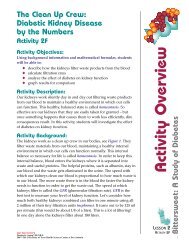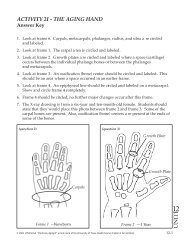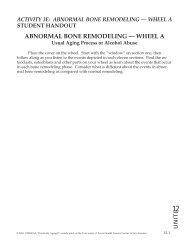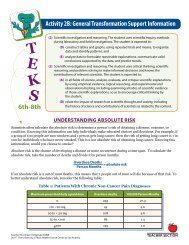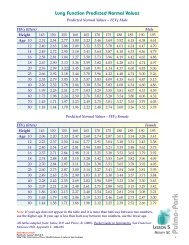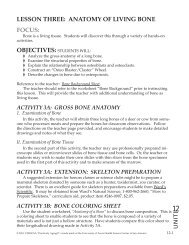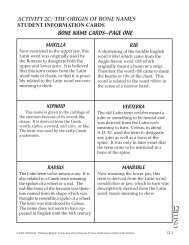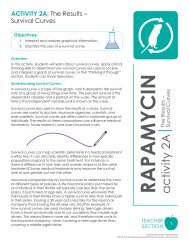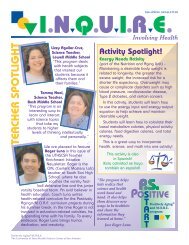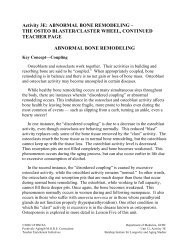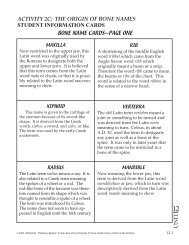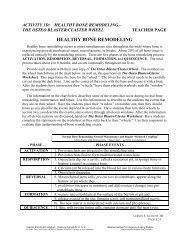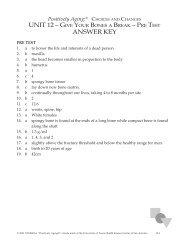The Brain: It's All In Your Mind - Teacher Enrichment Initiatives - The ...
The Brain: It's All In Your Mind - Teacher Enrichment Initiatives - The ...
The Brain: It's All In Your Mind - Teacher Enrichment Initiatives - The ...
You also want an ePaper? Increase the reach of your titles
YUMPU automatically turns print PDFs into web optimized ePapers that Google loves.
Make Up <strong>Your</strong> <strong>Mind</strong>: <strong>Brain</strong> Cap Activity<br />
Processing Out Activity 1B<br />
1. Why do you think the brain is designed to handle some tasks, such as<br />
keeping your heart beating, without your having to think about it?<br />
____________________________________________________________________<br />
______________________________________________________________________<br />
______________________________________________________________________________<br />
______________________________________________________________________________<br />
______________________________________________________________________________<br />
______________________________________________________________________________<br />
2. Rather than being located randomly throughout the brain, neurons that do a particular<br />
job are arranged in lobes. Why might this arrangement be more efficient?<br />
______________________________________________________________________________<br />
______________________________________________________________________________<br />
______________________________________________________________________________<br />
______________________________________________________________________________<br />
______________________________________________________________________________<br />
______________________________________________________________________________<br />
3. Wrinkle up a piece of notebook paper and observe what happens to its size.<br />
Now, consider the wrinkled surface of the CEREBRUM. How might the<br />
wrinkled surface affect the number of neurons in this portion of the brain?<br />
<strong>Mind</strong><br />
______________________________________________________________________________<br />
______________________________________________________________________________<br />
______________________________________________________________________________<br />
______________________________________________________________________________ <strong>Your</strong><br />
______________________________________________________________________________ <strong>In</strong><br />
______________________________________________________________________________<br />
4. Compare the CEREBELLUM with the CEREBRUM.<br />
<strong>All</strong><br />
a. How are they similar?<br />
________________________________________________________________________ It’s<br />
________________________________________________________________________<br />
______________________________________________________________<br />
______________________________________________________________<br />
______________________________________________________________<br />
______________________________________________________________ <strong>Brain</strong>:<br />
______________________________________________________________<br />
LESSON 1<br />
<strong>Teacher</strong> <strong>Enrichment</strong> <strong>In</strong>itiatives/CAINE<br />
ACTIVITY 1B <strong>The</strong><br />
2009©<strong>The</strong> University of Texas Health Science Center at San Antonio<br />
???<br />
9
. How are they different?<br />
___________________________________________________________<br />
___________________________________________________________<br />
___________________________________________________________<br />
___________________________________________________________<br />
___________________________________________________________<br />
________________________________________________________________________<br />
` ________________________________________________________________________<br />
c. Put your responses into the Venn diagram below.<br />
CEREBELLUM<br />
__________________________<br />
CEREBRUM<br />
__________________________<br />
__________________________<br />
__________________________<br />
__________________________<br />
__________________________<br />
__________________________<br />
__________________________<br />
SIMILARITIES<br />
__________________________<br />
__________________________<br />
__________________________<br />
__________________________ __________________________ __________________________<br />
__________________________ __________________________ __________________________<br />
__________________________ __________________________ __________________________<br />
__________________________ __________________________ __________________________<br />
__________________________ __________________________ __________________________<br />
__________________________ __________________________ __________________________<br />
__________________________ __________________________ __________________________ <strong>Mind</strong><br />
__________________________ __________________________ __________________________<br />
__________________________ __________________________ __________________________<br />
__________________________ __________________________ __________________________ <strong>Your</strong><br />
__________________________ __________________________ __________________________<br />
__________________________ __________________________ __________________________ <strong>In</strong><br />
__________________________ __________________________ __________________________<br />
__________________________ __________________________ __________________________ <strong>All</strong><br />
__________________________ __________________________ __________________________<br />
It’s <strong>Brain</strong>:<br />
LESSON 1<br />
<strong>Teacher</strong> <strong>Enrichment</strong> <strong>In</strong>itiatives/CAINE<br />
ACTIVITY 1B <strong>The</strong><br />
2009©<strong>The</strong> University of Texas Health Science Center at San Antonio<br />
10
5. <strong>In</strong> this activity, you have seen a model representing how the nerves from the<br />
brain come together in the BRAIN STEM and continue down through the<br />
vertebrae as the spinal cord. Spinal nerves branch out from different areas<br />
of the spinal column through the vertebrae. What do you think is the<br />
purpose of this branching?<br />
_________________________________________________________________<br />
_________________________________________________________________<br />
______________________________________________________________________________<br />
______________________________________________________________________________<br />
______________________________________________________________________________<br />
______________________________________________________________________________<br />
______________________________________________________________________________<br />
______________________________________________________________________________<br />
<strong>Mind</strong> <strong>Your</strong> <strong>In</strong> <strong>All</strong> It’s <strong>Brain</strong>:<br />
LESSON 1<br />
<strong>Teacher</strong> <strong>Enrichment</strong> <strong>In</strong>itiatives/CAINE<br />
ACTIVITY 1B <strong>The</strong><br />
2009©<strong>The</strong> University of Texas Health Science Center at San Antonio<br />
11



